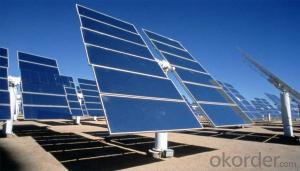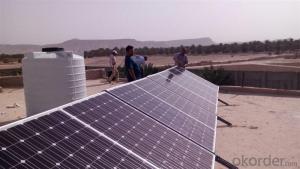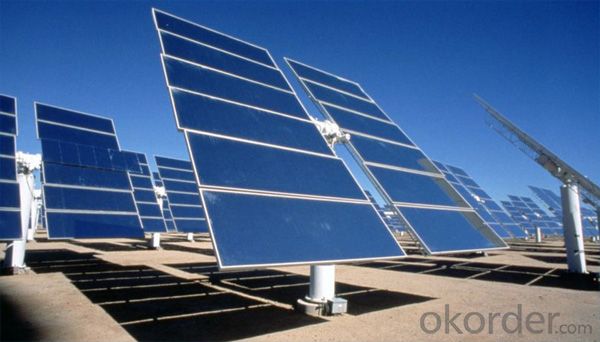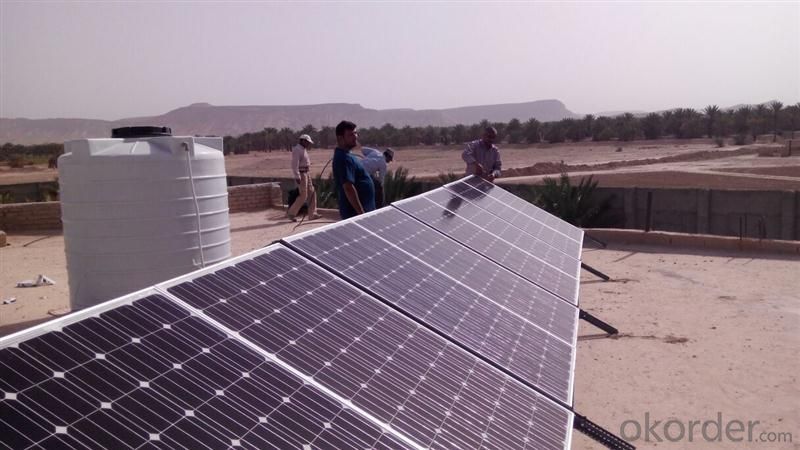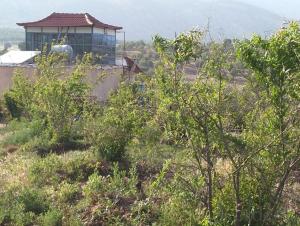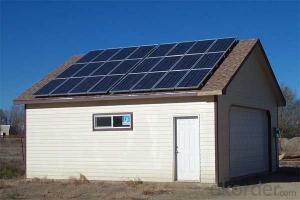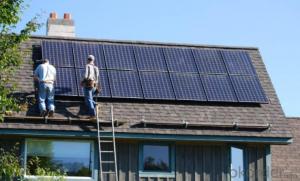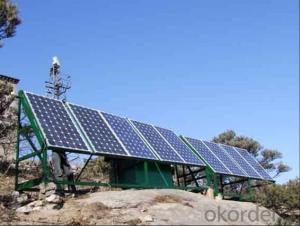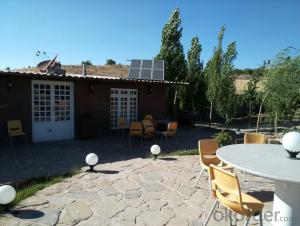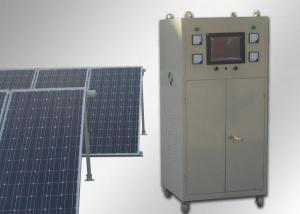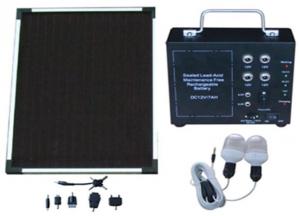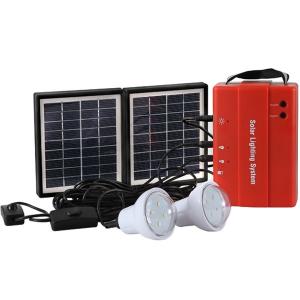Off-Grid Solar Power System 8KW High Efficiency
- Loading Port:
- China main port
- Payment Terms:
- TT OR LC
- Min Order Qty:
- 1 pc
- Supply Capability:
- 10000 pc/month
OKorder Service Pledge
OKorder Financial Service
You Might Also Like
1.Description of Product
Off-Grid Solar Power System is consisted of solar panel, solar charge controller, inverter, battery, mounting rack and cables.
(1).Grid-connected, send power to city grid
(2).MPPT technology, wide range of working voltage
(3).Simply Wiring, easy installation, customized design for your projects
(4).Low investment & long term feedback
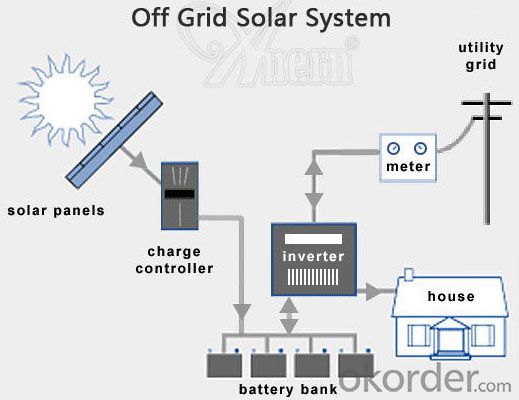
2. Off-Grid Features
1. Off grid solar power system is mainly used for application with relatively-small power consumption, and the areas have no grid network coverage, or grid power is unstable or outage condition.
2. It’s composed of solar panels, hybrid solar inverter, battery bank, solar panel mounting racks, and other accessories required fora complete home solar power system.
3. The battery bank gives a stable power output to the solar inverter which converts DC to AC to power loads, and provides power backup in rainy or cloudy days.
4. The solar panels generate electricity at daytime and charge the battery bank .
5. The off grid home solar power system provides grid power bypass in case of battery power shortage when sunshine is not enough.
6. All the off grid home solar power system configurations are worked out by scientific calculation and design.
The Product Parameter | |
Ref No. | 8KW |
Solar Panel | Type: Monocrystalline Silicon PV Module Max Power: 250W QTY:16 pcs |
Controller-Inverter Integrator | Rated Ouput Power: 5000W Rated DC Voltage: 48V QTY:1 pcs |
Battery | 12V/200AH per piece QTY:12 pcs |
Solar Panel Rack | Roof type mounting rack, anodized aluminum material, including complete fittings (Other type of racks can be customized as per client's requirement) QTY:1 pcs |
Cables | International standard, with specification suitable for solar system, BVV1*10 QTY:80m |
3.The Pictures of Product
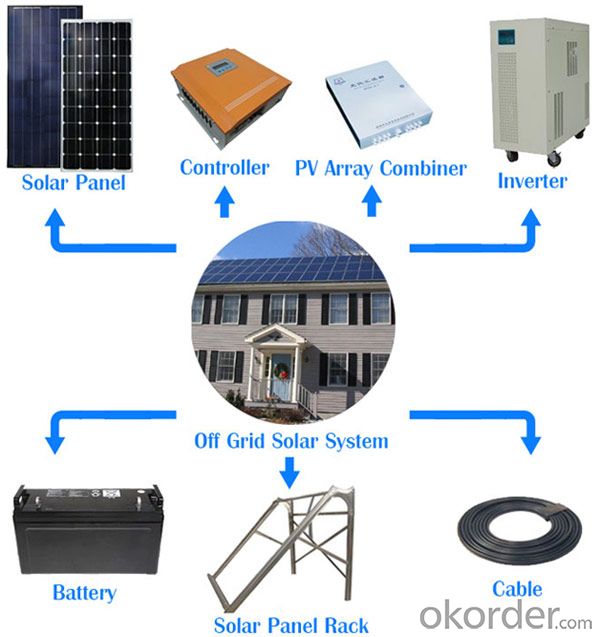

4.FAQ
Q1: What is the business type for the company?
A1: We are one of the biggest manufacturers inBejing.Chnia. Which is a high tech PV enterprise dedicated to the research, development, production and sales..
Q2: How long solar panel warranty can you offer?
A2: 10-Year product warranty,25-year linear power output warranty
If there is any quality problem, we will pay for freight and send free parts to you.
Q3: How many certificates do you have?
A3: We have 16 certificates,such as CE, TUV, UL, and so on.
Q4: Can I be the agent for you?
A4: Yes,We can discuss some information.
Q5: How to get a sample?How can cooperation with us
A5: contact us now.
- Q: What is the role of trackers in a solar energy system?
- The role of trackers in a solar energy system is to increase the efficiency and effectiveness of solar panels by following the movement of the sun throughout the day. This allows the panels to receive maximum sunlight exposure, optimizing the production of electricity.
- Q: Can solar energy systems be used in areas with high levels of wildlife activity?
- Yes, solar energy systems can be used in areas with high levels of wildlife activity. While it is true that wildlife can pose some challenges for solar energy systems, there are several ways to mitigate these issues. One of the primary concerns is the risk of damage to the solar panels by large animals or birds. However, there are various protective measures that can be taken to prevent this. For instance, installing fencing or barriers around the solar panels can help keep wildlife away. Additionally, using anti-reflective coatings on the panels can reduce the likelihood of bird collisions. Another concern is the impact of solar energy systems on wildlife habitats. It is crucial to choose the location of the solar panels carefully, considering the existing wildlife activity in the area. By conducting thorough environmental impact assessments and engaging with local wildlife experts, it is possible to minimize any potential negative effects on wildlife habitats. Moreover, solar energy systems can actually benefit wildlife in some cases. For example, solar farms can provide additional shelter and shade for some species, and the open spaces underneath the panels can create new habitats for ground-dwelling animals. Overall, while there may be some challenges, with proper planning and mitigation strategies, solar energy systems can be successfully utilized in areas with high levels of wildlife activity.
- Q: How do solar energy systems affect air conditioning costs?
- Solar energy systems can significantly reduce air conditioning costs by generating clean and free electricity to power the cooling system. By using solar power instead of relying solely on the grid, homeowners and businesses can reduce their electricity bills, as well as their dependence on fossil fuels. Additionally, solar energy systems can help reduce peak load on the grid during hot summer months, which can lead to lower electricity prices for everyone.
- Q: Can a solar energy system be used in areas with high levels of snowfall?
- Yes, a solar energy system can be used in areas with high levels of snowfall. While snow can temporarily reduce the system's efficiency, modern solar panels are designed to withstand snow loads and continue generating electricity. Additionally, snow can help to reflect sunlight and increase panel performance when it melts. Regular maintenance, such as clearing snow off the panels, can ensure optimal functionality.
- Q: Can a solar energy system be installed on a sports arena or stadium?
- A solar energy system is capable of being installed on a sports arena or stadium. In reality, numerous sports arenas and stadiums across the globe have already incorporated solar energy systems as a means of diminishing their carbon footprint and decreasing their energy expenses. These systems usually consist of sizable arrays of solar panels strategically positioned on the roof or in open areas adjacent to the facility. The solar panels absorb sunlight and transform it into electricity, which can be utilized to power various components of the arena or stadium, such as lighting, HVAC systems, and scoreboards. Moreover, any excess energy produced by the solar panels can be redirected back into the grid, further decreasing the facility's reliance on non-renewable energy sources. The installation of a solar energy system on a sports arena or stadium not only aids in the promotion of sustainability and environmental responsibility, but it also acts as a visible representation of the organization's dedication to renewable energy, inspiring others to do the same.
- Q: Can solar energy systems be used for powering off-grid cabins?
- Yes, solar energy systems can be used effectively for powering off-grid cabins. Solar panels can be installed on the roof or in a nearby location to capture sunlight and convert it into electricity. This electricity can then be stored in batteries for use during nighttime or cloudy days. With advancements in solar technology and efficient battery storage systems, off-grid cabins can rely primarily on solar power as a clean and sustainable energy source.
- Q: Can solar energy systems be used in powering theme parks or water parks?
- Yes, solar energy systems can definitely be used to power theme parks or water parks. Solar energy is a clean and renewable source of power that can provide a sustainable and cost-effective solution for meeting the energy needs of these establishments. Theme parks and water parks require a significant amount of electricity to operate attractions, lighting, water pumps, and other facilities. Installing solar panels can help reduce their reliance on conventional energy sources and decrease their carbon footprint. The large open spaces available in theme parks and water parks are ideal for installing solar panels, which can be mounted on rooftops, carports, or ground-mounted arrays. Solar energy systems can generate electricity by converting sunlight into usable energy through photovoltaic (PV) panels. These panels can be integrated into the infrastructure of the park discreetly and efficiently. The energy generated during the day can be used immediately to power rides, lighting, and other equipment, and any excess energy can be stored in batteries for use during periods of low sunlight or at night. Furthermore, solar energy systems can provide a reliable source of power and reduce the vulnerability of theme parks and water parks to power outages or disruptions in the grid. This is particularly important in areas prone to extreme weather events. By incorporating backup battery storage systems, solar energy can provide a constant and uninterrupted power supply even during emergencies. In addition to the environmental and reliability benefits, solar energy systems can also provide long-term cost savings for theme parks and water parks. While the initial installation cost might be higher, the operational costs are significantly reduced as the sun provides free and abundant energy. Over time, the savings on electricity bills can offset the initial investment, resulting in substantial cost savings for the park's owners. Overall, solar energy systems have the potential to revolutionize the power supply of theme parks and water parks. By harnessing the sun's energy, these establishments can not only reduce their environmental impact but also achieve long-term cost savings and enhanced energy reliability.
- Q: Can solar energy systems be used for powering off-grid construction sites?
- Yes, solar energy systems can be used to power off-grid construction sites. They provide a reliable and sustainable source of power, eliminating the need for traditional grid connections. Solar panels can be installed on-site to generate electricity, which can be stored in batteries for use during non-sunlight hours. This reduces dependence on fossil fuel generators, minimizes noise and air pollution, and promotes environmental sustainability in construction operations.
- Q: How do I calculate the return on investment for a solar energy system?
- To calculate the return on investment for a solar energy system, you need to determine the initial cost of the system and the annual savings or income generated by it. Divide the initial cost by the annual savings or income to obtain the payback period. To calculate the return on investment, subtract the initial cost from the total savings or income earned over the system's lifespan and divide it by the initial cost.
- Q: Can a solar energy system be installed on a building with multiple levels?
- Yes, a solar energy system can be installed on a building with multiple levels. The installation of a solar energy system depends on various factors such as the available space, orientation, and structural integrity of the building. In multi-level buildings, solar panels can be installed on the roof, balconies, or other suitable areas that receive adequate sunlight. Depending on the design and layout of the building, it may be necessary to install multiple solar arrays on different levels to maximize energy generation. Additionally, it is important to ensure that the building's electrical infrastructure can support the installation of a solar energy system. Overall, with proper planning and consideration of the building's characteristics, a solar energy system can be successfully installed on a building with multiple levels.
Send your message to us
Off-Grid Solar Power System 8KW High Efficiency
- Loading Port:
- China main port
- Payment Terms:
- TT OR LC
- Min Order Qty:
- 1 pc
- Supply Capability:
- 10000 pc/month
OKorder Service Pledge
OKorder Financial Service
Similar products
Hot products
Hot Searches
Related keywords
